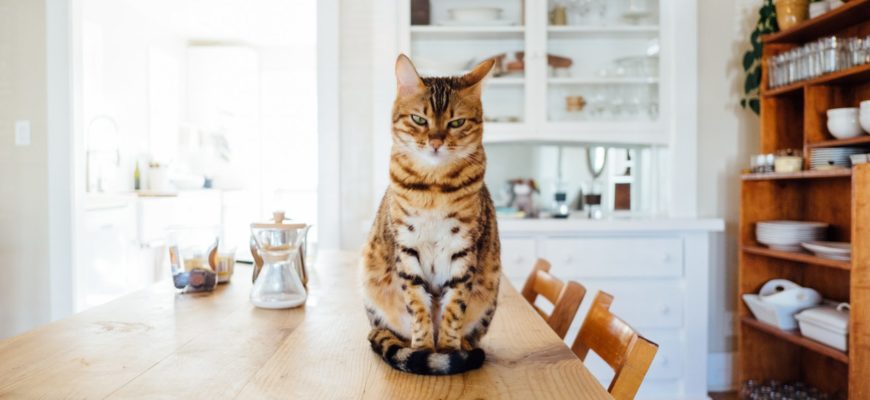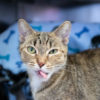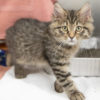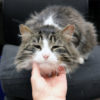Why Do Cats Like to Climb?
Cats climb for several reasons. They seek out high vantage points, like countertops and shelves, to survey their territory. They can leap onto bookshelves or scale curtains to escape from another household pet or from something that scares them. Tables and the top of the refrigerator often provide warm, sunny places to snooze. Cats can learn to patrol or “surf” countertops, stovetops and tables in search of tasty tidbits left behind.
Alternatives to Climbing on Countertops and Tables
It’s best not to stifle your cat’s normal jumping and climbing behavior. Your cat will be much happier if you can provide her with acceptable outlets for climbing, jumping, escaping, resting and inspecting the environment. If you don’t, your cat will likely persist in leaping up onto forbidden surfaces. Indoor cat “tree” furniture with natural bark or carpeting and comfortable platforms is an ideal substitute. Kitty condos (another type of indoor vertical furniture designed for cats), with abundant comfortable perching and sleeping areas, are very appealing to most cats. Offer plenty of comfortable nesting beds in warm areas or with burrowing material for extra warmth. Cats who like to gaze out windows or sleep in the sun appreciate commercially available kitty shelves that attach to window sills, which can be found at many pet stores. Providing your cat with furniture, shelves and appropriate climbing opportunities increases the vertical space in your home, opening up space to explore and hunt that mimics being on countertops in your home.
Perpetually hungry cats who explore kitchen countertops for food can be easier to discourage if they get more to eat. Feeding your cat several small meals a day on a set schedule can decrease their need to seek food in other places. Cats love routine, so providing them with a feeding schedule keeps them planted on the floor, ready for dinner, when the time is right. You can also look into specially designed food dispensing balls and puzzles that combine a fun game with a meal, also available at most pet stores. Be sure to put all desirable human food away so that your cat isn’t rewarded with tasty surprises when she hops up on counters.
Cats also often jump on surfaces to be close to their person, looking for attention or playtime. Making sure that you have a good routine of play and attention for your cat when you’re home, as well as making sure there are plenty of things for your cat to do while you’re away will help a lot to curb this attention seeking behavior while you’re eating or trying to work. Also offering an interactive toy, a battery operated toy or a game to keep your cat occupied during meal times or when you’re trying to work at your desk will offer them an appropriate alternative to jumping up when it’s not appropriate.
Discouraging Your Cat from Jumping on Countertops and Tables
If you provide your cat with alternatives for climbing and, at the same time, arrange the environment so that places like countertops and tables are uncomfortable for your cat, you may be able to teach her to avoid those specific areas.
You can dissuade your cat from entering banned areas by using environmental aversives which work without you being present. Cats are sensitive animals, so it’s never a good idea to shoo a cat away with your hands or threaten her with a spray bottle. Too often, your cat just learns to be afraid of you. Instead, create a situation where the inappropriate surface is undesirable to the cat. For instance, if your cat likes to jump from the floor onto the kitchen counter, balance some lightweight cookie sheets on the edge of the counter. When your cat jumps up, she’ll land on the sheets. They’ll move and possibly topple over, making some unpleasant noise while she leaps back onto the floor. Your cat shouldn’t be harmed by this experience, but she’ll be unlikely to risk jumping on the counter again. Similarly, you can try something that has an unpleasant texture on the counter tops. Double sided tape, aluminum foil and bubble wrap can all deter your cat from jumping onto a surface.
The main advantage to using an environmental aversive is that it happens whether you’re present or not. Your cat won’t learn to simply wait until it’s safe—until you’re not around—to do things like jump up on countertops and tables. Instead, she’ll discover that it’s never safe to do those things. Since you won’t always be there when the aversive works, she won’t associate the incident with you. You don’t want her to decide that you’re the scary thing!
What NOT to Do
- Do not scold your cat verbally, spank her or hit her for getting on countertops and tables. It’s highly unlikely that this kind of punishment will teach her to stay off. More likely, she’ll just become frightened of you.
- Do not shoo or push your cat off countertops and tables. She could fall and injure herself.
- Do not use any device to scare your cat away from forbidden areas if there’s a chance she could be physically harmed by the device. The point of an environmental aversive is to make your cat reluctant to return to a particular place. The intent is to startle her or make the place uncomfortable for her. There is no reason to physically harm your cat.
- Do not use environmental aversives to keep your cat away from a certain area if she’s especially skittish and nervous. She may become so frightened that she‘ll be reluctant to enter the room at all or even move around your home.







